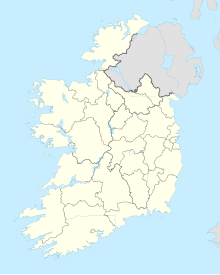Leacanabuaile
Coordinates: 51 ° 57 ′ 29 " N , 10 ° 15 ′ 42" W.
The Leacanabuaile Fort ( Irish Leaca na Buaile , Anglicised Lackanabooly ) is a restored medieval ring fort of a type that has only survived through a few structures in Ireland . Only the nearby Cahergall facility at Ballycarbery East, the Cathair at Lóthair and Staigue Fort (all in County Kerry ), Caherconnell and Caherdooneerish in County Clare, or Dun Aengus and Dún Chonchúir on the Aran island of Inis Meáin and the Grianán of Aileach in County Donegal is the same as Leacanabuaile. Leaca na Buaile is located west of Cahersiveen at Kimego West on the Iveragh Peninsula in County Kerry in Ireland.
While Cahergall is below, in the valley, this round stone fort is a few hundred meters away on a hilltop. The approximately 1.5 m high restored wall surrounds an area of around 20.0 m in diameter. It is about eight feet thick with the entrance to the east. Inside there are the remains of three marginal structures, one of which is a round beehive hut . A square house floor plan in the center was added irrelevantly. Inside there is a porthole and part of a hand rotary mill . Inside the round hut to the west, like the Cathair an Lóthair , there is access to a basement , the seven meter long corridor of which leads to a five meter long chamber inside the wall. A second chamber about three meters long is located in the northeast wall. A covered drainpipe leads from the area of the square house to the gate.
The excavation carried out in 1939/40 yielded iron knives and needles, bone combs, grindstones and hand mills or grinding stones . They helped to date the use of the complex to the 9th or 10th century AD.
300 m north of Leacanabuaile is Cahernagat (Cathair na gCat) a small round cashel on the lower slopes of Croaghmarhin. It is 17.3 m in diameter with a maximum wall thickness of 1.7 m and a height of 1.9 m. Inside are the remains of two round huts, a basement and an Ogham stone .
literature
- Matthew Stout : The Irish Ringfort (= Irish Settlement Studies. No. 5). Four Courts Press et al., Dublin 1997, ISBN 1-85182-300-X .
- Peter Harbison : Guide to the National Monuments in the Republic of Ireland. Gill and Macmillan, Dublin 1992, ISBN 0-7171-1956-4 , p. 117.

